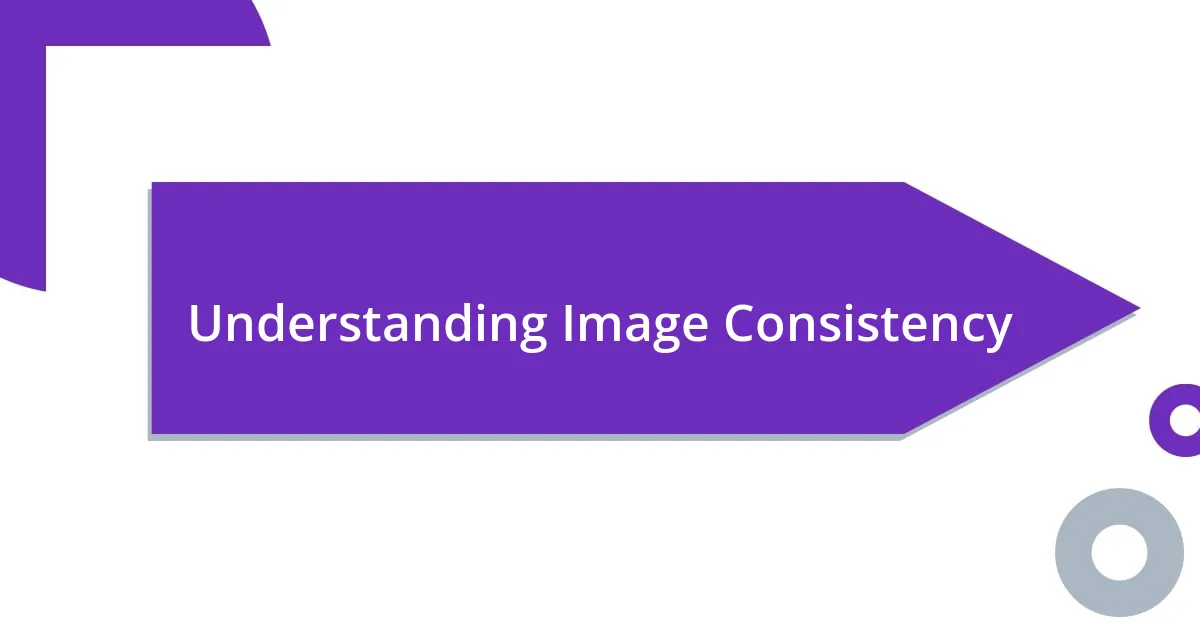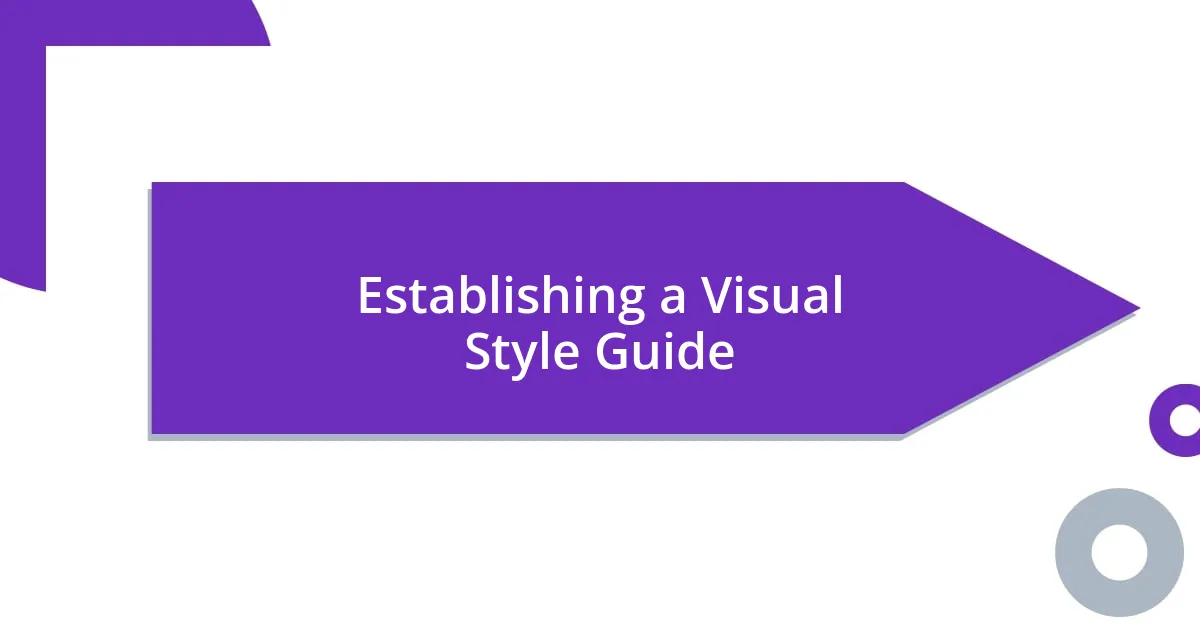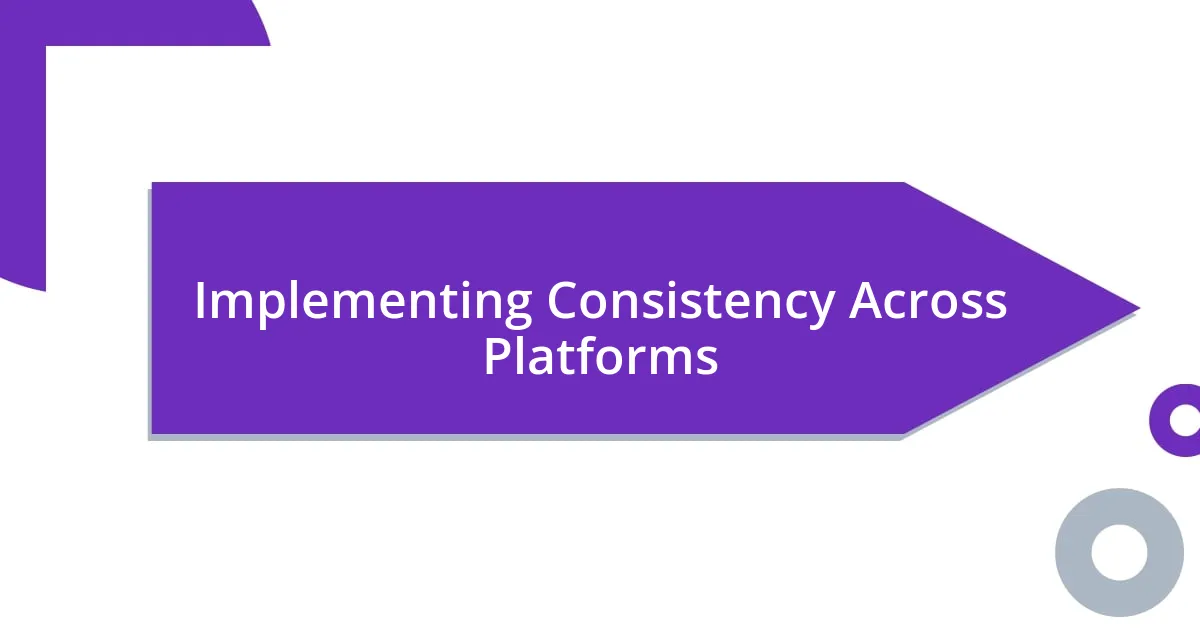Key takeaways:
- Image consistency is crucial for building brand recognition and trust; inconsistent visuals can confuse and alienate audiences.
- Establishing a visual style guide aids in maintaining a coherent identity across platforms, detailing elements like color palettes and typography.
- High photo quality and thoughtful use of color enhance emotional connections with the audience, fostering engagement and loyalty.
- Regularly evaluating and adjusting image strategies based on audience feedback ensures visuals remain impactful and relevant.

Understanding Image Consistency
Image consistency refers to the uniformity in how a brand or individual presents themselves visually across various platforms. I remember when I first started building my online presence; it struck me how crucial it was to maintain a cohesive look. Wouldn’t it be jarring to see a brand flip from bright, cheerful visuals one day to dark, moody images the next? It certainly would.
Having a consistent image helps ignite recognition and trust among your audience. I once experimented with changing my color palette for a project, and while I thought it would refresh my brand, it actually confused my followers. Why would someone unfamiliar with your work trust it if it looks different every time they encounter it?
When every visual element—from colors to typography—aligns with your core values, it communicates authenticity. I’ve learned that image consistency isn’t just about aesthetics; it’s a message—a promise of what to expect. Have you ever felt a particular connection to a brand boasting a well-defined image? I certainly have, and it’s that familiarity that fosters loyalty.

Importance of Consistent Imagery
Consistent imagery is essential for establishing a strong brand identity. I once stumbled upon a company whose visuals varied dramatically from social media to their website. It was like meeting two different brands! This inconsistency left me feeling uncertain about what they represented. When visuals match across platforms, they strengthen recognition, creating a lasting impression in the audience’s mind.
Another significant aspect of consistent imagery is the emotional connection it fosters. I recall a time when I saw a campaign that used similar colors and styles as another brand I loved. It instantly drew me in because I felt a sense of familiarity and comfort. When visuals are harmonious, they create a sense of belonging for the audience, making them more likely to engage and connect with the brand.
Moreover, consistent imagery can enhance communication effectiveness. I often emphasize to my peers how vital it is to convey a coherent message. For instance, brands that maintain visual consistency often enjoy better engagement rates. When an audience can quickly identify your visuals, they are more likely to interact with your content, whether it’s a blog post or an advertisement.
| Benefits of Consistent Imagery | Emotional Impact |
|---|---|
| Increased Brand Recognition | Fosters Trust and Loyalty |
| Improved Engagement Rates | Creates a Sense of Belonging |

Establishing a Visual Style Guide
Establishing a visual style guide is like giving your brand a personality—it defines who you are visually and consistently. When I first crafted my own guide, I found that it helped me articulate my choices, from fonts to colors. With a clear roadmap, everything I created felt more intentional and cohesive.
Here’s what I recommend including in your visual style guide:
- Color Palette: Define your primary and secondary colors, specifying where to use them.
- Typography: Choose fonts that reflect your brand’s voice, detailing sizes and styles for different contexts.
- Logo Usage: Outline how your logo should appear in various scenarios to maintain clarity and recognition.
- Imagery Style: Decide on the type of images that fit your brand—are they playful, professional, or something in between?
- Brand Voice: Even in visuals, having a tone—like friendly or serious—is crucial to staying consistent.
A well-rounded visual style guide not only simplifies your design process but also ensures that each piece of content emerges from the same recognizable place. I remember being astounded by how much smoother my projects became once I mapped everything out. The consistency became second nature, and that made my audience feel directed; they understood immediately what to expect from me.
Integrating all these elements into a guide encourages your visuals to tell a cohesive story. After all, who doesn’t want their audience to have a delightful and seamless experience?

Using Color Palettes Effectively
Creating an effective color palette is more than just picking pretty shades; it’s about crafting an emotional experience that resonates with your audience. I once worked on a project where I carefully selected a palette of soft pastels to convey a sense of calm and serenity. The responses I received were overwhelmingly positive, as people felt instantly relaxed just by looking at the visuals. Can you imagine the power a well-thought-out color scheme holds in evoking feelings and creating connections?
When I think about color theory, I can’t help but recall my initial misunderstanding of complementary colors. By pairing contrasting shades intentionally, I discovered how they can energize a design and draw attention to important elements. I remember the thrill of designing a promotional post where the vibrant orange popped against its cool blue background—it was striking and effective! Knowing how to use color relationships strategically can really amplify your message.
As you implement your color palette, consider context and consistency across platforms. I’ve made a habit of testing my colors against various backgrounds to ensure they always look their best. I vividly remember a time when a vibrant red looked utterly different on my website than in print. It was a learning moment that taught me to account for color variations in different settings. By being mindful of how colors interact across different mediums, you foster a unified brand identity that speaks louder and clearer to your audience.

Maintaining Photo Quality Standards
Maintaining high photo quality standards is essential for any visual brand. I still recall the time I submitted a set of images for a campaign, only to realize that a few of them were slightly out of focus. It was a frustrating moment, as I understood that clarity is vital—blurry photos can undermine the professionalism of the entire project. Ensuring sharpness across all visuals not only enhances the aesthetic appeal but also builds trust with your audience.
I’ve also learned the hard way about lighting and its impact on photo quality. Initially, I underestimated how much natural light could affect the mood of an image. During a photo shoot, we relied on artificial lighting, and the results were lackluster. Since then, I always aim to shoot in natural light or use soft diffusers to create a more inviting atmosphere. Have you ever noticed how a well-lit photo can elevate even the simplest subject? It’s all about making sure that every image represents the true essence of what I’m trying to convey.
Moreover, the technical aspects can’t be ignored. I prioritize using high-resolution images to maintain the crispness of details, especially for digital marketing. On several occasions, I’ve had my heart set on displaying intricate product shots, and it was disheartening when I had to downsize them for an ad without losing quality. That taught me to always keep originals and work with various sizes to fit different platforms seamlessly. By staying mindful of technical specifications like resolution and aspect ratio, I ensure that my visuals remain consistent and impactful across all channels.

Implementing Consistency Across Platforms
Once I began to implement a cohesive visual style across multiple platforms, I realized how much consistency could elevate my brand. For instance, I designed a series of social media graphics that echoed the same font and color palette used on my website. It was fascinating to see how this not only created a recognizable look but also enhanced my audience’s overall perception of professionalism. Have you experienced that “aha” moment when everything just clicks into place?
One crucial lesson I learned was to adapt my visuals without losing their essence. During a recent campaign, I had to modify images for different formats, like stories or posts. Initially, I thought resizing was straightforward, but I noticed some key elements got lost in translation. I remember adjusting one image to fit a square format and realizing the focal point had vanished. That taught me to be intentional in every graphic I create, keeping the core message intact no matter the size or medium.
Additionally, I’ve found that setting clear guidelines is essential for maintaining this consistency across platforms. By documenting specifications for logos, typography, and image styles, I’ve created a reference that is invaluable when it comes time to create new content. Sure, it may feel like an initial time investment, but I assure you, having these guidelines has streamlined my workflow and provided clarity in my branding process. I often ask myself, “How can I make my visuals more cohesive?” and these guidelines have truly been the answer.

Evaluating and Adjusting Image Strategies
When evaluating my image strategies, I often find it helpful to step back and honestly assess how my visuals resonate with my audience. There was a time when I was enamored with a particular editing style, believing it perfectly represented my brand. However, after monitoring engagement metrics, I noticed a decline in interaction. It made me question: was I prioritizing my aesthetic over my audience’s preferences? Adapting swiftly to these insights not only enhances my brand’s appeal but also reinforces my connection with viewers.
Adjusting my image strategies is an ongoing journey that requires both reflection and flexibility. I vividly recall a project where I needed to change the color grading of several images after a feedback session. Initially, I resisted the changes, thinking the edits would dilute my original vision. But once I embraced collaboration, the refreshed visuals felt more vibrant and relatable. Have you ever hesitated to embrace change, only to realize it unlocked a new level of creativity? That moment taught me that constructive criticism can be a powerful catalyst for growth.
It’s crucial to remain proactive in analyzing my visual content. I set aside time each month to review how my images are performing across different platforms. One day, I stumbled upon a particular style that really resonated with my audience, leading to higher engagement. Inspired, I decided to explore related themes and colors for subsequent campaigns. Keeping this iterative approach in mind allows me to refine my image strategies continually, ensuring my visuals not only maintain consistency but also evolve with the ever-changing tastes of my audience.













